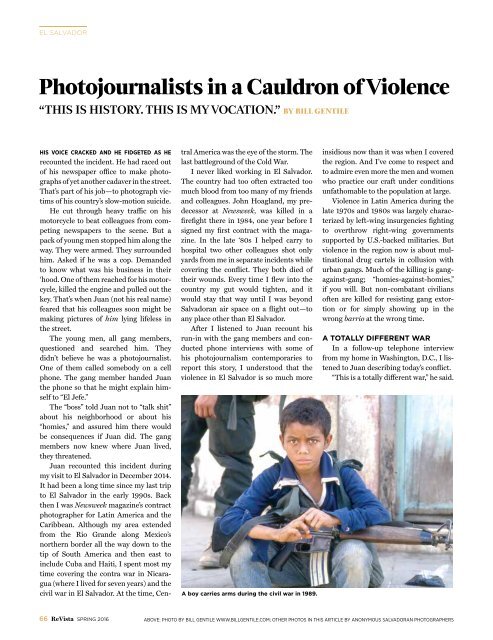EL SALVADOR
8clowSgZh
8clowSgZh
You also want an ePaper? Increase the reach of your titles
YUMPU automatically turns print PDFs into web optimized ePapers that Google loves.
<strong>EL</strong> <strong>SALVADOR</strong><br />
Photojournalists in a Cauldron of Violence<br />
“THIS IS HISTORY. THIS IS MY VOCATION.” BY BILL GENTILE<br />
HIS VOICE CRACKED AND HE FIDGETED AS HE<br />
recounted the incident. He had raced out<br />
of his newspaper office to make photographs<br />
of yet another cadaver in the street.<br />
That’s part of his job—to photograph victims<br />
of his country’s slow-motion suicide.<br />
He cut through heavy traffic on his<br />
motorcycle to beat colleagues from competing<br />
newspapers to the scene. But a<br />
pack of young men stopped him along the<br />
way. They were armed. They surrounded<br />
him. Asked if he was a cop. Demanded<br />
to know what was his business in their<br />
‘hood. One of them reached for his motorcycle,<br />
killed the engine and pulled out the<br />
key. That’s when Juan (not his real name)<br />
feared that his colleagues soon might be<br />
making pictures of him lying lifeless in<br />
the street.<br />
The young men, all gang members,<br />
questioned and searched him. They<br />
didn’t believe he was a photojournalist.<br />
One of them called somebody on a cell<br />
phone. The gang member handed Juan<br />
the phone so that he might explain himself<br />
to “El Jefe.”<br />
The “boss” told Juan not to “talk shit”<br />
about his neighborhood or about his<br />
“homies,” and assured him there would<br />
be consequences if Juan did. The gang<br />
members now knew where Juan lived,<br />
they threatened.<br />
Juan recounted this incident during<br />
my visit to El Salvador in December 2014.<br />
It had been a long time since my last trip<br />
to El Salvador in the early 1990s. Back<br />
then I was Newsweek magazine’s contract<br />
photographer for Latin America and the<br />
Caribbean. Although my area extended<br />
from the Rio Grande along Mexico’s<br />
northern border all the way down to the<br />
tip of South America and then east to<br />
include Cuba and Haiti, I spent most my<br />
time covering the contra war in Nicaragua<br />
(where I lived for seven years) and the<br />
civil war in El Salvador. At the time, Central<br />
America was the eye of the storm. The<br />
last battleground of the Cold War.<br />
I never liked working in El Salvador.<br />
The country had too often extracted too<br />
much blood from too many of my friends<br />
and colleagues. John Hoagland, my predecessor<br />
at Newsweek, was killed in a<br />
firefight there in 1984, one year before I<br />
signed my first contract with the magazine.<br />
In the late ‘80s I helped carry to<br />
hospital two other colleagues shot only<br />
yards from me in separate incidents while<br />
covering the conflict. They both died of<br />
their wounds. Every time I flew into the<br />
country my gut would tighten, and it<br />
would stay that way until I was beyond<br />
Salvadoran air space on a flight out—to<br />
any place other than El Salvador.<br />
After I listened to Juan recount his<br />
run-in with the gang members and conducted<br />
phone interviews with some of<br />
his photojournalism contemporaries to<br />
report this story, I understood that the<br />
violence in El Salvador is so much more<br />
A boy carries arms during the civil war in 1989.<br />
insidious now than it was when I covered<br />
the region. And I’ve come to respect and<br />
to admire even more the men and women<br />
who practice our craft under conditions<br />
unfathomable to the population at large.<br />
Violence in Latin America during the<br />
late 1970s and 1980s was largely characterized<br />
by left-wing insurgencies fighting<br />
to overthrow right-wing governments<br />
supported by U.S.-backed militaries. But<br />
violence in the region now is about multinational<br />
drug cartels in collusion with<br />
urban gangs. Much of the killing is gangagainst-gang;<br />
“homies-against-homies,”<br />
if you will. But non-combatant civilians<br />
often are killed for resisting gang extortion<br />
or for simply showing up in the<br />
wrong barrio at the wrong time.<br />
A TOTALLY DIFFERENT WAR<br />
In a follow-up telephone interview<br />
from my home in Washington, D.C., I listened<br />
to Juan describing today’s conflict.<br />
“This is a totally different war,” he said.<br />
66 ReVista SPRING 2016 ABOVE: PHOTO BY BILL GENTILE WWW.BILLGENTILE.COM; OTHER PHOTOS IN THIS ARTICLE BY ANONYMOUS <strong>SALVADOR</strong>AN PHOTOGRAPHERS


